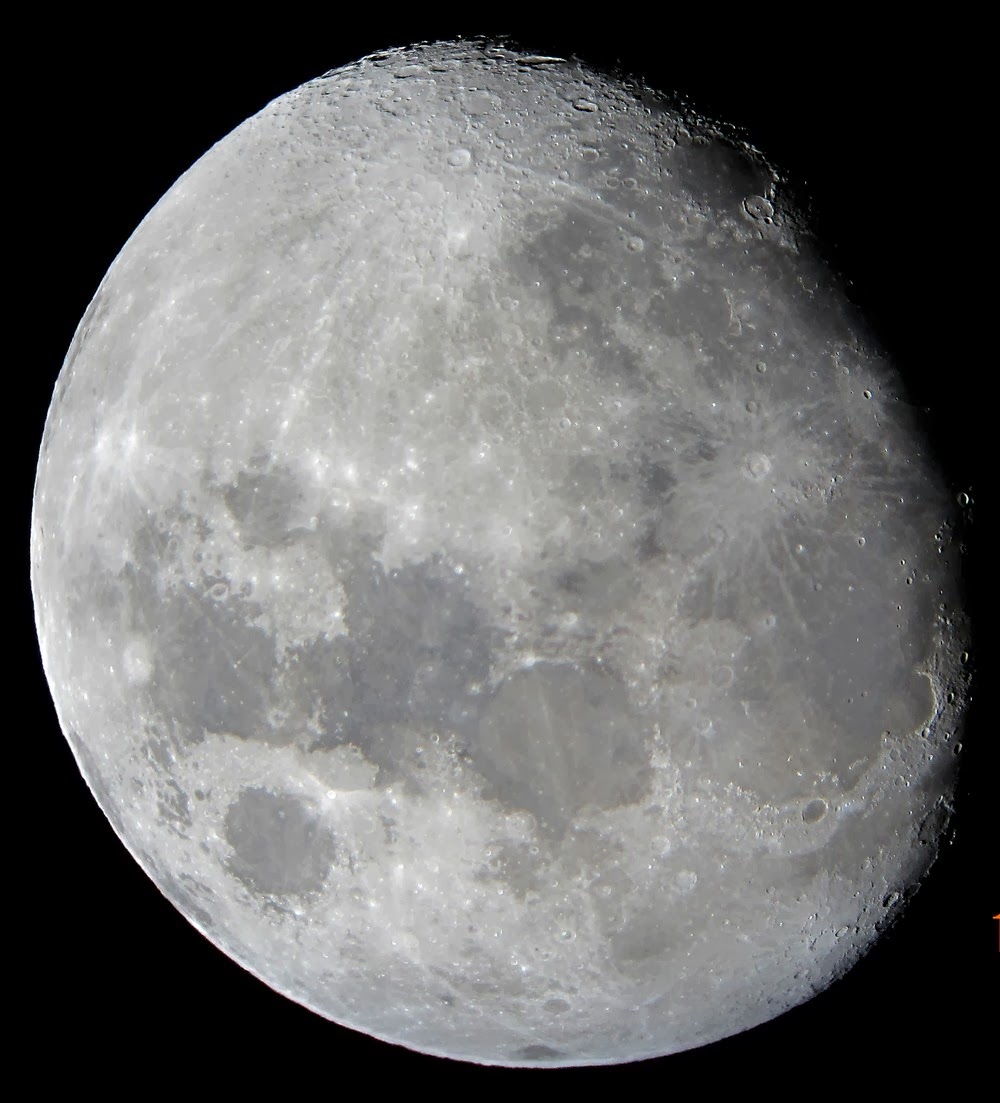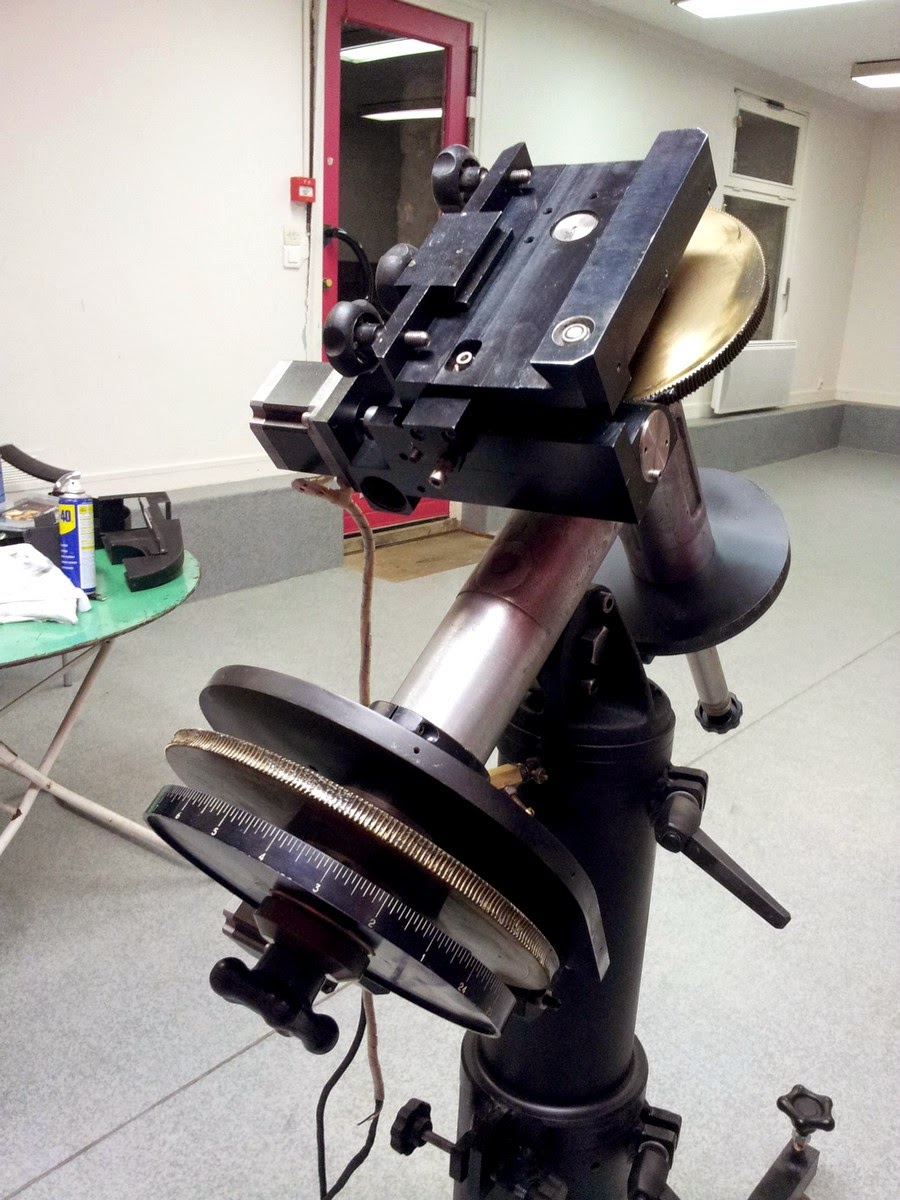*
For the first time in what seems several months the sky is clear without a howling gale. I dragged the MkIV mounting to where I could catch the rising Moon over the 20' eastern hedge.
I had found and tried the Cheshire and discovered the focussing mount was not square to the secondary. I slipped a galvanised nut under one edge and re-tightened the screws. That's better!

The Moon was at 25 degrees altitude when I first started observing. Creeping up to 35 degrees before I went in for a cup of tea and a slice of Christmas cake to scribble some notes on my blog.
Jupiter is still too low to align the telescope on it but is rising quickly now. Though it is still at a very low altitude.
Initial impressions on the moon at 100x and 135x is much increased sharpness. 200x was much too soft until the Moon reached 40 degrees altitude.
High frequency thermal effects are causing a constant rippling of the image. Stars are slightly elongated and not very small. I don't believe the optics are pinched. Infra and extra focal expanded images are round but jagged edged.
Going back out now:
By about 7pm the moon reached 40 degrees altitude and suddenly the central crater popped out as a small white spot. at 135x. (15mm)
I was still unable to see the crater at 100x. Thermal agitation gradually reduced with increasing altitude.
One oddity was a complete reversal of the light breeze. A thin streak of smoke was wafting horizontally from our chimney lit by the bright moonlight. Though this wind was undetectable where I was standing
Meanwhile Jupiter became accessible from my observing position though it was still only at 20 degrees altitude. Two clear belts visible but struggling for finer detail. I spent another hour going up and down in power until it reached 30 degrees. There was some slight increase in contrast on the belts but nothing very impressive. The four Jovian moons were easily seen and slowly shrank in size with altitude gained. At higher powers it was easy to see rotating thermal effects on the Jovian limb.
Soon everything was sparkling with frost though I was not suffering from any dewing on the optics. The earlier, heavy plates of cloud had disappeared. To be replaced but a long streak of thin, high cloud appearing from the NW. It looked rather like a diffuse searchlight beam. For some peculiar reason this "cloud" formed a perfectly clear circle around the moon and then travelled under it and onwards.

Towards the end I brought out the short zoom, Canon compact camera to take some handheld snaps at the eyepiece. I seem to have mislaid my favourite 20mm no-name Plossl photography eyepiece. This fits the adaptor I made out of a plastic bottle top. The combination provides perfect centring and a reasonable power on my refractors. Though 20mm may be too "powerful" for the F:8 10".
The moon image was taken with a 26mm Meade 4000 Plossl. ( Nominal 78x) Cropped to enlarge and resized smaller for the blog.
Four hours in total under rather pleasant observing conditions. I packed up at 8pm for dinner with more, thin high cloud arriving. Both my quarries were both still too low for best seeing. Thermal agitation was a constant feature.
Telescope collimation is still not perfect but sneaking towards it. There is some vibration when I touch the telescope but it soon damps down. Having the drives fitted would remove the need to more the telescope by hand. Though I have yet to re-attach the worms and slow motion drives to the MkIV mounting. The mirror fan has yet to be connected to a power supply even experimentally. Blackening in the optical path only amounts to an A4 piece of thin, black foam attached with clothes pegs opposite the focuser.
Clear nights have been exceptionally rare this year. Rather dimming my enthusiasm for further telescope building or observing. I remain determined to find a raised yet sheltered site which will allow permanent set-up for observing. Almost anything would be an improvement on having to move the entire instrument and its separate mounting around the garden. The mature trees and high hedges provide shelter from the constant winds but block most of the sky.
I used a laser rangefinder, with an accurate digital clinometer, to measure the altitude of the telescope tube as the evening progressed. This made my own estimates of altitude (by eye) look rather foolish. I was being far too optimistic by as much as 10 degrees. Over the years I have usually noticed a distinct improvement in seeing when an object was above 45 degrees altitude.
Click on any image for an enlargement.
*
 A contact has kindly shared the sale of a rather sophisticated Fullerscopes Mk111:
A contact has kindly shared the sale of a rather sophisticated Fullerscopes Mk111:








